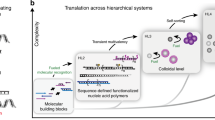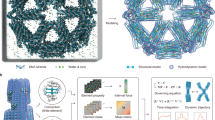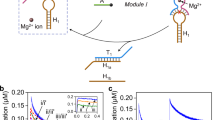Abstract
In nature, self-assembling and disassembling complexes of proteins and nucleic acids bound to a variety of ligands perform intricate and diverse dynamic functions. In contrast, attempts to rationally encode structure and function into synthetic amino acid and nucleic acid sequences have largely focused on engineering molecules that self-assemble into prescribed target structures, rather than on engineering transient system dynamics1,2. To design systems that perform dynamic functions without human intervention, it is necessary to encode within the biopolymer sequences the reaction pathways by which self-assembly occurs. Nucleic acids show promise as a design medium for engineering dynamic functions, including catalytic hybridization3,4,5,6, triggered self-assembly7 and molecular computation8,9. Here, we program diverse molecular self-assembly and disassembly pathways using a ‘reaction graph’ abstraction to specify complementarity relationships between modular domains in a versatile DNA hairpin motif. Molecular programs are executed for a variety of dynamic functions: catalytic formation of branched junctions, autocatalytic duplex formation by a cross-catalytic circuit, nucleated dendritic growth of a binary molecular ‘tree’, and autonomous locomotion of a bipedal walker.
This is a preview of subscription content, access via your institution
Access options
Subscribe to this journal
Receive 51 print issues and online access
$199.00 per year
only $3.90 per issue
Buy this article
- Purchase on Springer Link
- Instant access to full article PDF
Prices may be subject to local taxes which are calculated during checkout





Similar content being viewed by others
References
Butterfoss, G. L. & Kuhlman, B. Computer-based design of novel protein structures. Annu. Rev. Biophys. Biomol. Struct. 35, 49–65 (2006)
Seeman, N. C. DNA in a material world. Nature 421, 427–431 (2003)
Turberfield, A. J. et al. DNA fuel for free-running nanomachines. Phys. Rev. Lett. 90, 118102 (2003)
Bois, J. S. et al. Topological constraints in nucleic acid hybridization kinetics. Nucleic Acids Res. 33, 4090–4095 (2005)
Green, S. J., Lubrich, D. & Turberfield, A. J. DNA hairpins: Fuel for autonomous DNA devices. Biophys. J. 91, 2966–2975 (2006)
Seelig, G., Yurke, B. & Winfree, E. Catalyzed relaxation of a metastable DNA fuel. J. Am. Chem. Soc. 128, 12211–12220 (2006)
Dirks, R. M. & Pierce, N. A. Triggered amplification by hybridization chain reaction. Proc. Natl Acad. Sci. USA 101, 15275–15278 (2004)
Rothemund, P. W. K., Papadakis, N. & Winfree, E. Algorithmic self-assembly of DNA Sierpinski triangles. PLoS Biol. 2, 2041–2053 (2004)
Seelig, G., Soloveichik, D., Zhang, D. Y. & Winfree, E. Enzyme-free nucleic acid logic circuits. Science 314, 1585–1588 (2006)
Yurke, B., Turberfield, A. J., Mills, J. A. P., Simmel, F. C. & Neumann, J. L. A DNA-fuelled molecular machine made of DNA. Nature 406, 605–608 (2000)
Winfree, E., Liu, F., Wenzler, L. A. & Seeman, N. C. Design and self-assembly of two-dimensional DNA crystals. Nature 394, 539–544 (1998)
Shih, W. M., Quispe, J. D. & Joyce, G. F. A 1.7-kilobase single-stranded DNA that folds into a nanoscale octahedron. Nature 427, 618–621 (2004)
Rothemund, P. W. K. Folding DNA to create nanoscale shapes and patterns. Nature 440, 297–302 (2006)
Seeman, N. C. Nucleic acid junctions and lattices. J. Theor. Biol. 99, 237–247 (1982)
Feldkamp, U. & Niemeyer, C. M. Rational design of DNA nanoarchitectures. Angew. Chem. Int. Edn Engl. 45, 1856–1876 (2006)
Robertson, A., Sinclair, A. J. & Philp, D. Minimal self-replicating systems. Chem. Soc. Rev. 29, 141–152 (2000)
von Kiedrowski, G. A self-replicating hexadeoxynucleotide. Angew. Chem. Int. Edn Engl. 25, 932–935 (1986)
Paul, N. & Joyce, G. F. A self-replicating ligase ribozyme. Proc. Natl Acad. Sci. USA 99, 12733–12740 (2002)
Levy, M. & Ellington, A. D. Exponential growth by cross-catalytic cleavage of deoxyribozymogens. Proc. Natl Acad. Sci. USA 100, 6416–6421 (2003)
Lee, D. H., Granja, J. R., Martinez, J. A., Severin, K. & Ghadiri, M. R. A self-replicating peptide. Nature 382, 525–528 (1996)
Zhang, D. Y., Turberfield, A. J., Yurke, B. & Winfree, E. Engineering entropy-driven reactions and networks catalyzed by DNA. Science 318, 1121–1125 (2007)
Li, Y. et al. Controlled assembly of dendrimer-like DNA. Nature Mater. 3, 38–42 (2004)
Yin, P., Yan, H., Daniell, X. G., Turberfield, A. J. & Reif, J. H. A unidirectional DNA walker that moves autonomously along a track. Angew. Chem. Int. Edn Engl. 43, 4906–4911 (2004)
Tian, Y., He, Y., Chen, Y., Yin, P. & Mao, C. A. DNAzyme that walks processively and autonomously along a one-dimensional track. Angew. Chem. Int. Edn Engl. 44, 4355–4358 (2005)
Bath, J., Green, S. J. & Turberfield, A. J. A free-running DNA motor powered by a nicking enzyme. Angew. Chem. Int. Edn Engl. 44, 4358–4361 (2005)
Pei, R. et al. Behavior of polycatalytic assemblies in a substrate-displaying matrix. J. Am. Chem. Soc. 128, 12693–12699 (2006)
Venkataraman, S., Dirks, R. M., Rothemund, P. W. K., Winfree, E. & Pierce, N. A. An autonomous polymerization motor powered by DNA hybridization. Nature Nanotechnol. 2, 490–494 (2007)
Asbury, C. L. Kinesin: world's tiniest biped. Curr. Opin. Cell Biol. 17, 89–97 (2005)
Dirks, R. M., Bois, J. S., Schaeffer, J. M., Winfree, E. & Pierce, N. A. Thermodynamic analysis of interacting nucleic acid strands. SIAM Rev. 49, 65–88 (2007)
Dirks, R. M., Lin, M., Winfree, E. & Pierce, N. A. Paradigms for computational nucleic acid design. Nucleic Acids Res. 32, 1392–1403 (2004)
Flamm, C., Fontana, W., Hofacker, I. L. & Schuster, P. RNA folding at elementary step resolution. RNA 6, 325–338 (2000)
Hansma, H. G. & Laney, D. E. DNA binding to mica correlates with cationic radius: assay by atomic force microscopy. Biophys. J. 70, 1933–1939 (1996)
Acknowledgements
We thank the following for discussions: J. S. Bois, R. M. Dirks, M. Grazier G'Sell, R. F. Hariadi, J. A. Othmer, J. E. Padilla, P. W. K. Rothemund, T. Schneider, R. Schulman, M. Schwarzkopf, G. Seelig, D. Sprinzak, S. Venkataraman, E. Winfree, J. N. Zadeh and D. Y. Zhang. We also thank J. N. Zadeh, R. M. Dirks and J. M. Schaeffer for the use of unpublished software, and R. F. Hariadi and S. H. Park for advice on AFM imaging. This work is funded by the NIH, the NSF, the Caltech Center for Biological Circuit Design, the Beckman Institute at Caltech, and the Gates Grubstake Fund at Caltech.
Author information
Authors and Affiliations
Corresponding author
Ethics declarations
Competing interests
P.Y. and N.A.P. have applied for a patent on the molecular motif and reaction graph abstraction.
Supplementary information
Supplementary Information
The Supplementary Information is divided into eight sections and contains Supplementary Figures S1-S40 with Legends and additional references. Section 1 contains a summary figure. Section 2 contains reaction graph conventions. Section 3 contains notes on the catalytic geometry systems: hierarchal design process for catalytic formation of a 3-arm junction, execution of the reaction graphs, design and experimental results for catalytic formation of a 4-arm junction, AFM image analysis of 3-/4-arm junctions, design for the catalytic formation of a k-arm junction. Section 4 contains notes on the catalytic circuitry system: execution of the reaction graph, detailed secondary structure mechanism, stepping gel, system kinetic analysis. Section 5 contains notes on the nucleated dendritic growth system: execution of the reaction graph, detailed secondary structure mechanism, quantitative amplification gel, AFM image analysis. Section 6 contains notes on the autonomous locomotion system: execution of the reaction graph, secondary structure of the walker system, detailed secondary structure mechanism, assembly of the walker system, characterization of the fuel system, raw data for the fluorescence quenching experiments, statistical analysis, comparison of walker time scales, control for walker landing effects. Section 7 contains notes on the discussion: leakage and ligation, molecular compiler. Section 8 contains the DNA sequences for all the systems. (PDF 4606 kb)
Rights and permissions
About this article
Cite this article
Yin, P., Choi, H., Calvert, C. et al. Programming biomolecular self-assembly pathways. Nature 451, 318–322 (2008). https://doi.org/10.1038/nature06451
Received:
Accepted:
Issue Date:
DOI: https://doi.org/10.1038/nature06451
This article is cited by
-
Enhancing intracellular mRNA precise imaging-guided photothermal therapy with a nucleic acid-based polydopamine nanoprobe
Analytical and Bioanalytical Chemistry (2024)
-
A sensitive and rapid electrochemical biosensor for sEV-miRNA detection based on domino-type localized catalytic hairpin assembly
Journal of Nanobiotechnology (2023)
-
Molecular system for an exponentially fast growing programmable synthetic polymer
Scientific Reports (2023)
-
In situ self-assembly for cancer therapy and imaging
Nature Reviews Materials (2023)
-
A simple and sensitive electrochemical biosensor for circulating tumor cell determination based on dual-toehold accelerated catalytic hairpin assembly
Microchimica Acta (2023)
Comments
By submitting a comment you agree to abide by our Terms and Community Guidelines. If you find something abusive or that does not comply with our terms or guidelines please flag it as inappropriate.



